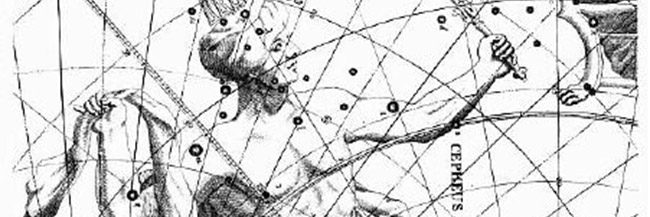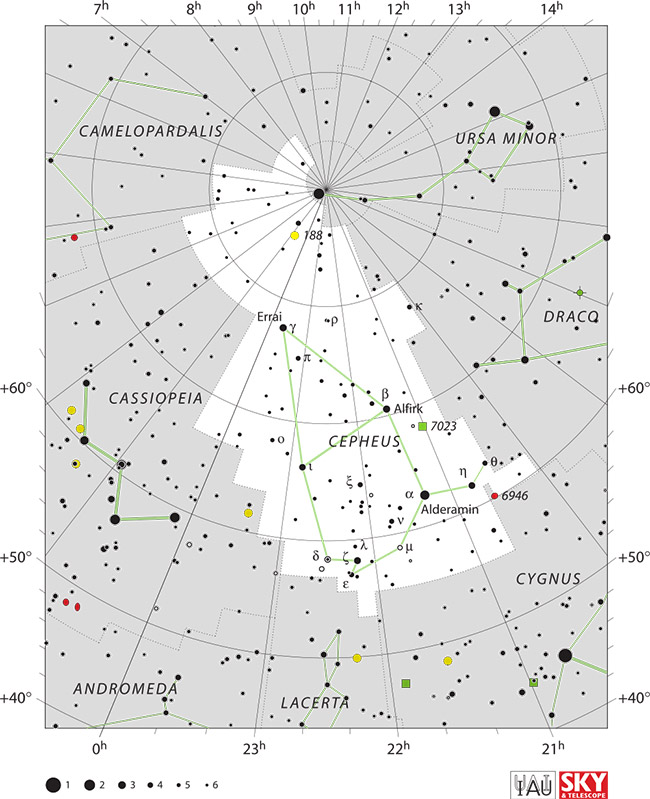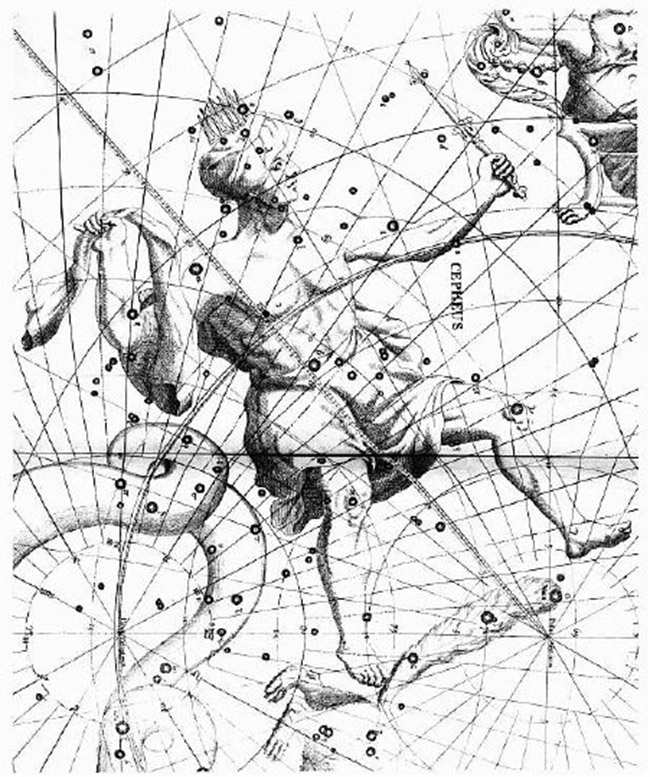Cepheus – Constellation Facts

Cepheus represents King Cepheus who was the husband of Cassiopeia and the father of Andromeda (who also have constellations). It lies in the fourth quadrant of the Northern hemisphere and is located specifically between latitudes of +90° and -10°. Along with other constellations, Cepheus was first catalogued in the 2nd century by, Ptolemy, a Greek astronomer.
Constellation Characteristics
Cepheus is the 27th largest constellation in the night sky, occupying 588 square degrees. Cepheus is also neighbors with Camelopardalis, Cassiopeia, Cygnus, Draco, Lacerta and Ursa Minor. In addition, this constellation has ten main stars and seven deep space objects, but no Messiers or meteor showers. However, it is home to the famous red supergiant named, Garnet Star.

IAU and Sky & Telescope magazine (Roger Sinnott & Rick Fienberg), CC BY 3.0, via Wikimedia Commons
By IAU and Sky & Telescope magazine (Roger Sinnott & Rick Fienberg) CC BY 3.0, via Wikimedia CommonsPlanetary Systems
Cepheus has seven deep sky objects. Read on to discover some fascinating facts about these celestial wonders.
- The Fireworks Galaxy (NGC 6946, Arp 29, Caldwell 12): this intermediate spiral galaxy has nine supernova and is located 22 million light-years away.
- The Wizard Nebula (NGC 7380): located 7,000 light-years away, this open star cluster is relatively young (less than five million years-old). It is also with the Milky Way and embedded in a nebulae.
- NGC 7538: classified as a reflection nebula, NGC 7538 also contains the biggest protostar known. It is 300 times the size of the solar system and can be located inside the “Perseus Spiral Arm of the Milky Way Galaxy.”
- NGC 188 (Caldwell 1): lying approximately 5 degrees from the North Celestial Pole, this open cluster is one of the oldest ones known today.
- The Iris Nebula (NGC 7023, Caldwell 4): this star cluster is embedded inside a nebula and is located about 1,300 light-years away.
- NGC 7129: taking on the shape of a rosebud, this open cluster has more than 130 young stars, which are believed to be less than a million years-of-age.
- NGC 7142: even though this open cluster is thought to be the oldest one, it still contains many young blue stars. It is located in proximity to NGC 7129, but is hidden by an interstellar cloud.
Main Stars
The constellation Cepheus contains ten main stars that makes up its shape. Let’s explore them further.
- Alderamin (Alpha Cephei) shines the brightest in the Cepheus constellation (which will be discussed later in detail).
- Alfirk (Beta Cephei) is located around 690 light-years away and is classified as a triple star. The brightest component is Alfirk A, a blue giant with a slow rotation (28 kilometers-per-second) taking 51 days to complete a full rotation.
- Delta Cephei is a double star in the class of Cepheids; varying in luminosity due to surface pulsations. The brighter component is a yellow-white F-class supergiant, the lesser is a B-class star.
Alrai (Gamma Cephei) is categorized as a binary star. The first component is believed to be around 6.6 billion years-old and is an orange subgiant, the second one is an M4 class red dwarf. - Zeta Cephei lies 730 light-years away and has eight times the mass of the Sun. It is classified as an orange subgiant and burns at a temperature of 4,310 kelvins.
- Eta Cephei is also known as, Al Kidr and is located about 45 light-years from Earth.
- Garnet Star (Mu Cephei) is an M bright supergiant and is one of the brightest and largest stars ever known. It has a radius 1,650 times that of our Sun; however, the interstellar dust does obscure its luminosity.
- VV Cephei (HD 208816) is an eclipsing binary star with its brightest component (hypergiant, VV Cephei A) being the third largest star known today.
- V381 Cephei is a pulsating variable star classified as a red supergiant. It has nine to ten solar masses and lies 3,663 light-years away.
- Kruger 60 is composed of two red dwarfs that orbit around each other.

Cepheus depicted in the Atlas Coelestis of John Flamsteed (1729).
Cepheus depicted in the Atlas Coelestis of John Flamsteed (1729).Most Shining Star
Out of all the stars that make up the Cepheus constellation, none shine brighter than Alderamin (Alpha Cephei). This white class A star is currently evolving from a main sequence star into a subgiant and never sets below the horizon. It can be seen with the naked eye from Canada, Europe, Northern Asia and most of North America. Alderamin gets its name from the Arabic phrase, að-ðirā‘ al-yamīn, which means “the right arm.”
Mythology & History
As Greek mythology tells the tale, Cepheus was the king of Ethiopia and the husband of Cassiopeia. One day Cassiopeia bragged to the sea nymphs of her beauty being higher than them all. The nymphs were outraged and in retaliation asked Poseidon to punish the arrogant Queen. Poseidon being married to one of the sea nymphs was happy to oblige and summoned a sea monster (Cetus the Whale) to ravage the land.
When the water came, Cepheus turned to a oracle for help. It told him he and Cassiopeia would have to sacrifice their daughter, Andromeda, to appease the sea monster. Cepheus obliged and chained Andromeda to a stone; however, before the monster could take her Perseus rescued her and they were later married.
As the story goes, Phineas (a former lover of Andromeda) attended the wedding in order to claim Andromeda. He was outnumbered and in the battle used Medusa’s head to turn his opponents into stone. In the haste and fooliness, Cepheus and his wife looked at the head and were instantly turned to stone. Poseidon then placed both the king and queen into the sky to commemorate the incident.
Cepheus is a fascinating constellation, so the next time you are gazing into the night sky, be sure to search out this intriguing figuration of stars.
